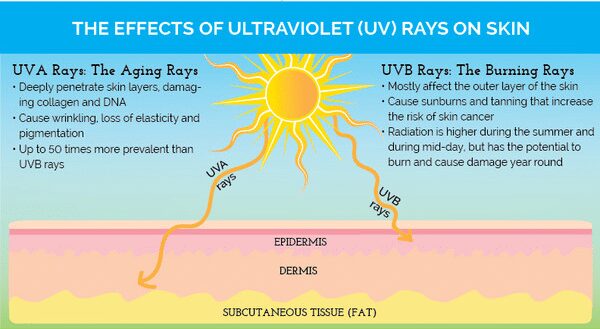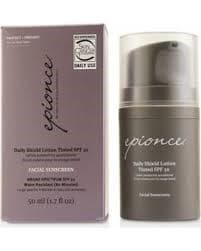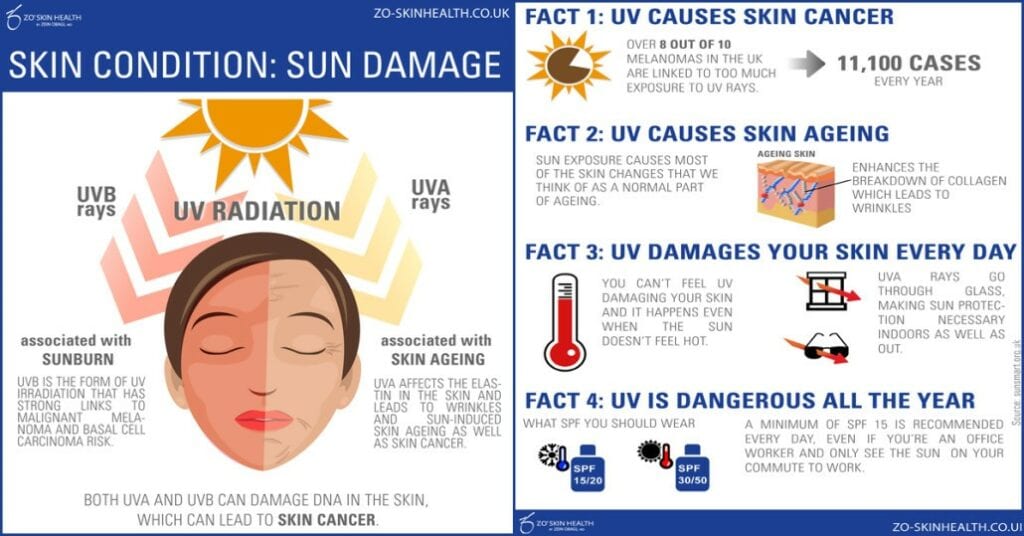Sunscreen. Yes, sunscreen! Did you know that the sun is responsible for 98% of the aging of our skin? Most of us don’t think of sunscreen as an anti-aging tool, but it is by far THE most important anti-aging component of any great skin care regime. Without this protective foundation, I would venture to say that any other skin care product on your skin is a waste of time and financial investment.
UV rays cause skin aging by increasing free radicals in the skin that cause the DNA of our skin cells to break down, and this interferes with the ability of our skin to repair itself over time. UV rays increase enzymes in the skin that promote collagen breakdown and decrease the protective enzymes that prevent this from happening in the first place… that’s a double whammy of damage! This contributes to destruction of collagen and elastin that eventually leads to the development fine lines, wrinkles, volume loss, sun spots (hyperpigmentation) and even visible broken blood vessels (telangectasias).

Key elements of a great anti-aging sunscreen:
- Use a non-toxic chemical or physical protectant. Some ingredients can cause damage to your skin and hormones, as well as harm the environment.
- GOOD = zinc oxide, titanium oxide, avobenzone
- BAD = oxybenzone, octinoxate, oxysalate, homosalate
- What’s the difference between physical and chemical barriers? – Physical barriers (zinc and titanium oxides) are not absorbed into the skin but create a reflection barrier. Chemical barriers are organic compounds that are absorbed and they contain a carbon molecule that changes the way molecules interact with eachother.
- Always use Broad Spectrum: This will provide more coverage for both UVA and UVB.
- Did you know? SPF (sun protection factor) is only a measurement of protection against UVB, not UVA. Some countries apply a rating system for UVA protection to their broad-spectrum sunscreens. The USA does not.
- Use no less than an SPF of 50. This will protect you about 98% from UV rays.
Product Highlight:

One of my favorite sunscreens that we currently carry is the Epionce Daily Shield Tinted SPF 50. It uses a combination of zinc oxide and titanium dioxide to create a matrix that reflects infrared, HEVL (high energy visible light), blue light, heat and pollution. It also contains anti-inflammatory botanicals and antioxidants to further protect your skin from damage. This product is light yet moisturizing on my skin and has a soft feel. It can be worn under makeup as a flawless primer, and I use it as my sole makeup base every morning. This product also has the Skin Cancer Foundation’s Seal of Recommendations for meeting safety and efficacy. It also comes in a non-tinted form.
Tips on how to apply your sunscreen:
- Apply liberally to all exposed areas. The recommended amount for the entire body is 1 full ounce (or 1 shot glass size amount) to all exposed areas.
- Apply to cool, dry skin. NOT warm, wet skin.
- Don’t forget! Be sure to apply to prime target areas for skin cancer, such as the entire neck and ears.
- Twice is Nice: Did you know that you’re probably not applying the correct amount of sunscreen? SPF value is determined by presumed application of a layer of product that is 2mg/cm thick. When investigated, it turns out that most individuals do not apply it this thick and in fact apply less than half of this recommended amount, rendering the SPF value of their sunscreen to actually be 50% less protective than what the label suggests! For the best protection, apply 1 layer of sunscreen, then wait 15-30 minutes for it to settle into the microscopic grooves of the skin before applying a 2nd protective layer. Reapplication while outdoors should occur every 2 horus.
- Wear it every day ~ Inside or outside, Rain or shine: UV rays still penetrate through dark and cloudy days, glass windows and inside buildings.
- But how will I get Vitamin D??? Enjoy your sun exposure with caution. No safe threshold exists for UV sun exposure that will increase Vitamin D but will also minimize cancer risk.
- Maximize your Protection: You can maximize your protection and preserve the age and health of your skin by adding Vitamin C to your morning skin care regime. This helps to prevent collagen and elastin breakdown by adding antioxidants to your skin that reduce free radical formation and protect your tissue from UV damage

References:
Relationship between sun-protection factor and application thickness in high-performance sunscreen: double application of sunscreen is recommended.
https://www.ncbi.nlm.nih.gov/pubmed/23050556
Sunscreen applied at ≥ 2 mg cm-2 during a sunny holiday prevents erythema, a biomarker of ultraviolet radiation-induced DNA damage and suppression of acquired immunity.
